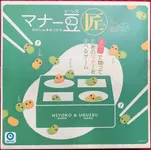Go-Moku (700)
Playtime: 5
Min. Age: 8
Players: 2
Publisher: John W. Hill & Co., Shuāng Hóu (双猴), ABRA, (Unknown), L. P. Septímio, Schmidt International, Alga, Spear's Games, IQ Products, (Public Domain), Duàn De Lǐ (段的理), John Jaques of London, Werner & Schumann, Otto Maier Verlag, Arxon, Jumbo, ASS Altenburger Spielkarten, Grubbe Media GmbH, Palet spil, Watilliaux, Copp Clark Publishing Company, Το Καλό Παιχνίδι Α.Ε., Jian Lun (剑伦)
Designers: (Uncredited)
Artists: Manfred Burggraf
Mechanics: Pattern Building, Square Grid
Min. Age: 8
Players: 2
Publisher: John W. Hill & Co., Shuāng Hóu (双猴), ABRA, (Unknown), L. P. Septímio, Schmidt International, Alga, Spear's Games, IQ Products, (Public Domain), Duàn De Lǐ (段的理), John Jaques of London, Werner & Schumann, Otto Maier Verlag, Arxon, Jumbo, ASS Altenburger Spielkarten, Grubbe Media GmbH, Palet spil, Watilliaux, Copp Clark Publishing Company, Το Καλό Παιχνίδι Α.Ε., Jian Lun (剑伦)
Designers: (Uncredited)
Artists: Manfred Burggraf
Mechanics: Pattern Building, Square Grid
Show Description Show Comments Price Trend
"Go-Moku" (Japanese - also spelled "Gomoku") or "wuziqi" (Chinese) is a very old game played with a Go set. The game can also be played on a sheet of graph paper using X's and O's. It is similar in idea to tic-tac-toe, but far greater in scale and complexity. The name means "five points."
It is debated whether this game originated in China or Japan, with more evidence pointing to the former.
The object is to get five stones in a row. The game is played on a 19x19 board (such as the board used in Go), creating a large and open field to complete this objective. The game can also be played on a smaller board, such as the popular 15x15 option.
If played perfectly, Black (who goes first) can always win the game. Even before this was proven, the game was recognized to be easier for Black. This problem is solved in Renju. which is often seen as the adult contemporary to the kids' Go-Moku.
It is debated whether this game originated in China or Japan, with more evidence pointing to the former.
The object is to get five stones in a row. The game is played on a 19x19 board (such as the board used in Go), creating a large and open field to complete this objective. The game can also be played on a smaller board, such as the popular 15x15 option.
If played perfectly, Black (who goes first) can always win the game. Even before this was proven, the game was recognized to be easier for Black. This problem is solved in Renju. which is often seen as the adult contemporary to the kids' Go-Moku.
We currently have no price data for this game.
This game is currently not traded on the marketplace:
This game is currently not listed on the marketplace. If you want to sell yours, please add it to the marketplace.
Marketplace
The game was also published under these names:
Kreuzeln ,
Go Bang ,
Go & Gobang ,
Fünf in einer Reihe ,
Gewinn mit 5 ,
Go-Bang ,
5 på stribe ,
Go-Moku ,
五子棋 ,
Five in a Row ,
Gin Checkers ,
Gomoku ,
Jätkänshakki ,
Amőba ,
Go+Gobang ,
Go-Muku ,
Go Und Gobang ,
Gomoku-narabe ,
Comoko ,
Gobang ,
Fem på Stribe ,
Wu Zi Qi
Related Games
ag.gameitem.lastUpdated: 2025-06-06 06:45:17.171

















